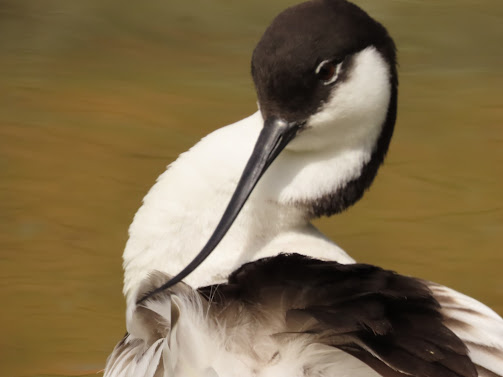Its a strange thing in the world of bird watching that often the best places for bird photography aren't necessarily the best for seeing birds. Ok this may sound strange but stay with me as I try to explain what this means. Like Lackford Lakes and Sculthorpe Moor, Pensthorpe fits into this category. Whenever I visit I always come away with a lot of photos, some of them good, but I wont have seen anything unusual birdwise, just the ones you'd expect. But that's not doing Pensthorpe a disservice, its a great place to visit, good for everyone really, not so much a reserve as a destination.
It also helps that Pensthorpe has a collection of captive birds, ones to get close up to and photograph in good conditions. The main focus of Pensthorpe is the Wader Aviary. Here, there are captive birds that have no fear of humans, ones you could reach out and touch if you felt like doing so. My favourite are the RUFFS, the males of which look amazing in their puffed up plumage of many colours, no two birds looking the same. AVOCETS, GODWITS, STILTS, GARGANEYS all reside here, with TURTLE DOVES and BEARDED TITS flying about, rare British birds that are difficult to find in the wild. As well as the visual delights, the Aviary rocked to the sound of the CORNCRAKE, crex crexing, and TURTLE DOVES purring, two evocative sounds now largely gone from our countryside.
Venturing out into the reserve, the first lakes also feature captive birds, with a collection of waterfowl, those native to Europe at least. The captive RED BREASTED GEESE rubbed shoulders with feral BARNACLE GEESE, the latter's grey goslings begging for food along with CANADA, GREYLAG and EGYPTIAN GEESE, all descended from captive birds, turned wild and now returned to captivity.
The focus of the reserve are the many lakes, former gravel pits, now overgrown with vegetation, so that they now look natural. The usual sort of waterfowl resided on this sort of habitat, the denizens of this water boom. COOT families were a feature here, with around fifteen pairs hanging around with their ugly red headed young; there were three pairs of GREAT CRESTED GREBE and one SWAN pair. A few GADWALL were about, but there were loads of TUFTED DUCK, with as many as twenty pairs on the various waters. Three pairs off COMMON TERN were about nesting on artificial rafts, as well as plenty of BALCK HEADED GULL fitting into any place that could take their nest, trees, islands, rafts, they're not fussy.
The two focal points of the reserve are the Wader Scrape and the Wensum Wetland two areas of wetland on opposite sides of the reserve. The Wader Scrape was your typical scrape, as I've been describing on every recent Norfolk post, shallow water with islands, a boon for birds. At Pensthorpe the scrape had been completely taken over by BLACK HEADED GULLS with hundreds of them packed onto the islands, their stick nests all crowded in with each other, all squabbling away. Four AVOCET pairs were present, with some sitting, while a pair of LAPWING resided, although I didn't see any young; a pair of OYSTERCATCHER was also about. There were two pairs of SHOVELLER on the water, a female TEAL and a brood of six lovely, stripy SHELDUCK ducklings which swam closely to their parents.
The Wensum Wetland was similar, but with deeper water, islands as well, but was more luxuriant, but being new had areas of open mud. A nice LAPWING chick was seen feeding inbetween the clumps of sedge and the many goslings. Also about were two pairs of SHOVELLER on the water, as well as the usual suspects.
Aside from the lakes the reserve is a very lovely mixture of wildflower meadows, riverside grazing, woodland and formal gardens. On the edges of the reserve, its very quiet, with few people about and it can be quite idyllic just wondering a landscape which would have been common in any river valley up and down the country half a century ago. Over this bucolic landscape a CUCKOO was calling, a bird that has been a real feature of my visit to North Norfolk.
Aside from the reserve there were further captive birds and formal gardens, where most of the humans hung out. A sign told me that GREATER FLAMINGOES were present in a pond, although for some reason they decided to hide away out of my view. Three species of CRANE were present, observable from a hide, with each different opening looking at a different species. EURAISIAN CRANE, CROWNED CRANE and RED CROWNED CRANE, were all there, beautiful, graceful birds up there as the true aristocracy of birds.
Pensthorpe is such a nice place to visit, if only every so often. Its kind of handy being close to the North Norfolk Coast that you can include it in a stay up there. As you can see I returned with a great bounty of photographs. Now you can see the task I had in looking through maybe a thousand photos to just pick out these few for this blog. As it is in photography for every hundred photos you took, maybe one or two are usuable, and the ratio is even greater for good photos. But that is all the fun of birdwatching, how bloody annoying and difficult it can be, but how rewarding it is in the end.
















No comments:
Post a Comment